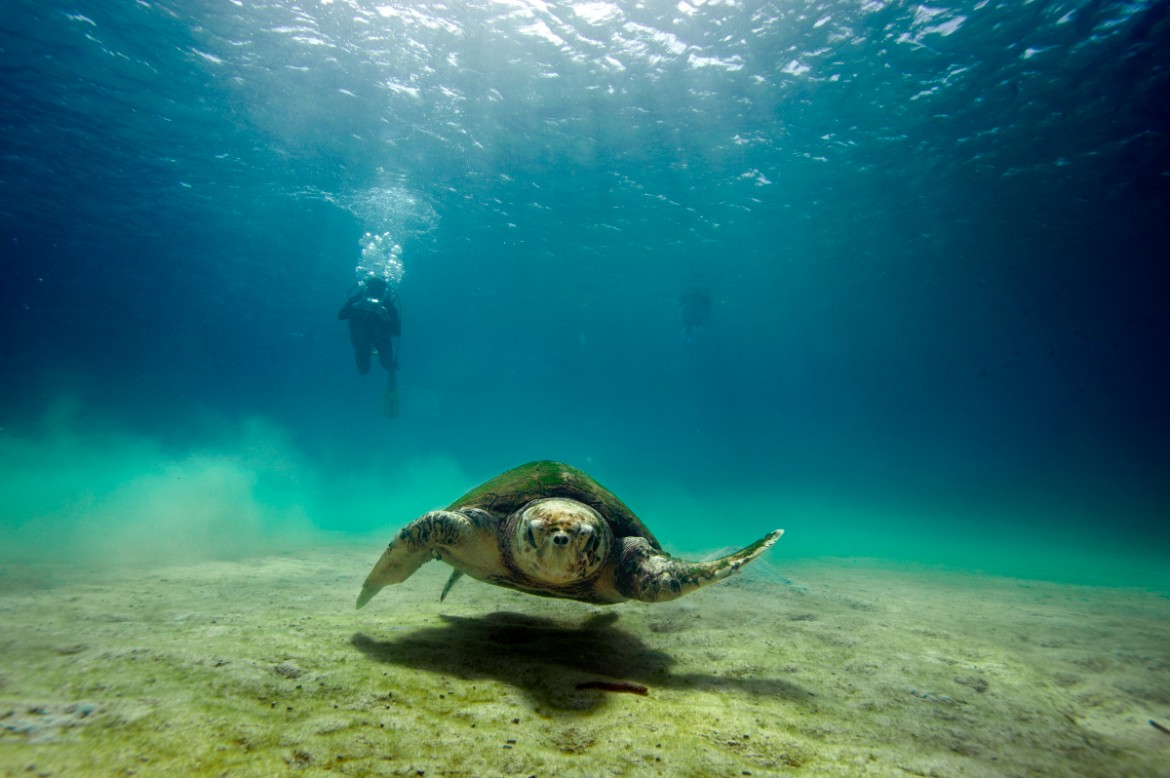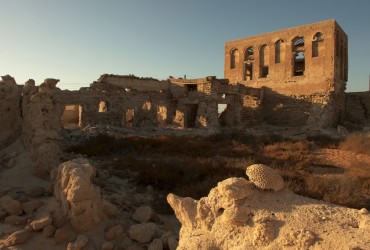To tackle the issue from a different angle
“Today is the big day!” shouts Daniela Freggi who is holding a little plastic cup of strong coffee in her hand, when she sees us arriving at the clinic. “I hope you had a good night of sleep, because the surgery could last several hours…” she adds with a smile.
A tall man with short grey hair is standing next to Daniela but a little behind her. “Let me introduce you”, she says, smiling and affectionately pulling him by the arm. “This is my friend Antonio di Bello who is a veterinary surgeon. He arrived yesterday on Lampedusa with the evening plane. We met at a congress in 2003. Since that day, every time we need him, he travels from Bari in Apulia at his own expense.” Turning to face him, she adds with a grin: “Now that I think of it, you seem to be coming less and less often!”
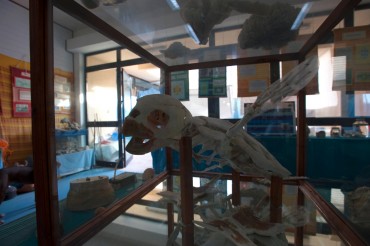 A simple explanation: “When we met back in 2003, the centre collected and healed between 500 and 600 turtles. Today, it is hardly a hundred turtles that are brought to us… Either the turtles’ mortality rate is higher, or there are fewer fishermen to collect them and bring the animals to the clinic. I would say it is a bit of both” concludes Daniela.
A simple explanation: “When we met back in 2003, the centre collected and healed between 500 and 600 turtles. Today, it is hardly a hundred turtles that are brought to us… Either the turtles’ mortality rate is higher, or there are fewer fishermen to collect them and bring the animals to the clinic. I would say it is a bit of both” concludes Daniela.
It is hardly 11 a.m. and the sun is already dramatically heating the rocky island. A breeze is starting to appear in the port. We take the opportunity to go for a walk before we confine ourselves to the operation room.
“I have been working for a long time with animals… let’s say more conventional than marine turtles, explains Antionio di Bello while we walk next to the wooden fishing boats anchored in front of the centre. One day, a colleague of the WWF in the Basilicata region sent me some injured turtles. One had been hit by a boat, and the other one had a nylon string that was coming out of her tail. These cases were very interesting for me, but at that time I had no idea how to take care of them. Anatomically speaking, I knew almost nothing of these marine animals.”
In 2000, the surgeon is given a dead turtle of around 20 kilos. This was the chance for him to dissect it and to learn about their anatomy. “At first, it was common to apply the surgery techniques of terrestrial turtles and cut open the belly bone of the marine turtles, explains Antonio. The problem is that it is a very heavy surgery for the animal, and the recovery from it can take three to four years. I took it as a challenge, and came to the conclusion that it is possible to have access to almost all of the animal’s organs from the soft tissue next to their legs. After such a surgery that is much lighter, the turtles only need a few weeks of care and observation.”
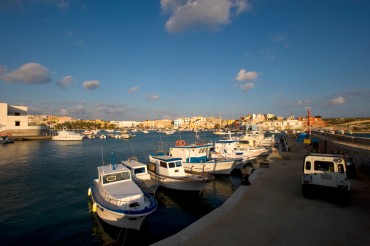 Later in the discussion, I find out what encouraged him to study these animals that don’t seem very sympathetic at first glance. His answer is simple: curiosity.
Later in the discussion, I find out what encouraged him to study these animals that don’t seem very sympathetic at first glance. His answer is simple: curiosity.
“I like them because they are mysterious. With the more conventional animals, an important bond exists between the animal and its owner” Antionio smiles when he points towards Daniela and her dogs playing in front of the clinic. “This is a bond that has never occurred between man and turtle. They are so ancient, yet we know little to nothing about them…”
Daniela is walking towards us, and she takes the time to say hello to every Italian fisherman that is on his boat anchored in front of the centre. I am mesmerized by her ability to chat with people that are notorious for not being very talkative. “If you only knew… , she tells me. It took me years! At first, I was forced to get on board and listen to them talk about anything and everything. You can’t imagine the number of home movies that I have watched, just to get a little bit of their attention. But it was worth it. Rather than throw a turtle that they had caught by mistake back at sea, like they used to do, now they think of me.”
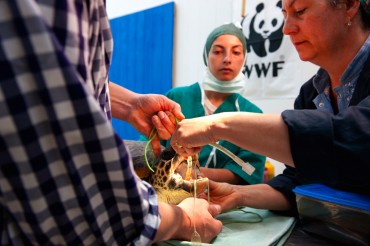 We finally get into the surgery bloc, exactly like one we would find in any hospital. The bed is in the middle, the trays of instruments on the side. In a corner of the room, a scale and the X-ray machine. In front of a light panel, Antionio is studying the latest X-rays that he made this morning. He wants to localise with precision where the hook is trapped in the guts of the turtle that is calmly lying in its plastic tray on the scale. On the display we can read 25 kg. “She is between 15 and 20 years old, explains Daniela. She’s a teenager that will reach puberty in 10 years or so. To give you an idea, the oldest marine turtles ever observed weighed between 150 and 180 kg, they were studied in England. This equals to a marine animal of 150 years old!”
We finally get into the surgery bloc, exactly like one we would find in any hospital. The bed is in the middle, the trays of instruments on the side. In a corner of the room, a scale and the X-ray machine. In front of a light panel, Antionio is studying the latest X-rays that he made this morning. He wants to localise with precision where the hook is trapped in the guts of the turtle that is calmly lying in its plastic tray on the scale. On the display we can read 25 kg. “She is between 15 and 20 years old, explains Daniela. She’s a teenager that will reach puberty in 10 years or so. To give you an idea, the oldest marine turtles ever observed weighed between 150 and 180 kg, they were studied in England. This equals to a marine animal of 150 years old!”
While Antiono and two volunteers are getting ready by putting on the traditional sterile hats, blouses and gloves, Daniela keeps improving our knowledge of these extraordinary reptiles. “I don’t know if some of you are sensitive to the sight of blood? When Antonio will start cutting through the skin, don’t be surprised by the purple colour of the blood. It’s perfectly normal, marine turtles have a haemoglobin rate seven times higher than the human. When a turtle gets to the surface for a breath of fresh air, it’s just as if you would breathe seven times before diving back down. This biological characteristic is what allows the turtle to sleep from 40 minutes up to an hour without breathing, depending on the size of the animal.” After hearing what Daniela just said, Sebastien, the skipper of the crew, and Philippe can’t resist sending me mocking smiles. They know that free diving isn’t my favourite activity. By far.
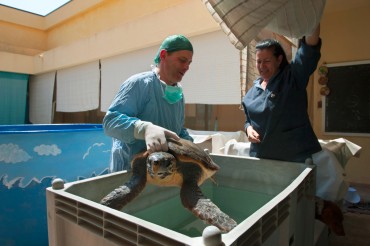 I then spot Antionio who is very focused, the anaesthetic syringe in hand, ready to put the turtle to sleep. “Sometimes, I wonder if what we do really makes a difference… admits Antionio while delicately pricking the animal. But every time, I quickly dismiss this idea. I have been working on turtles for 15 years, and each day I discover new fascinating things”.
I then spot Antionio who is very focused, the anaesthetic syringe in hand, ready to put the turtle to sleep. “Sometimes, I wonder if what we do really makes a difference… admits Antionio while delicately pricking the animal. But every time, I quickly dismiss this idea. I have been working on turtles for 15 years, and each day I discover new fascinating things”.
“And you haven’t seen anything yet. Wait a few days, we are planning to give back their freedom to five turtles. You’ll see first-hand how such a clumsy animal on earth can become so graceful once in the water” adds Daniela before turning the lights off in the surgery bloc, leaving only the powerful beam of light coming from the surgery lamp.
>>> Chapter 4 published next week <<<
